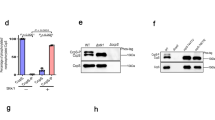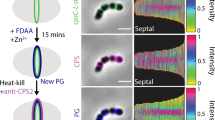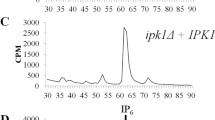Abstract
The polysaccharide capsule is one of the established virulence factors in Cryptococcus neoformans that provides a barrier against the host-mediated immune response. Mutation of the gene encoding the Saccharomyces cerevisiae Sch9 protein kinase homologue resulted in cells with enlarged capsules in C. neoformans. Capsule production was abrogated in sch9 pka1 double mutants, indicating that protein kinase A (PKA) signaling is still necessary for capsule formation in sch9 mutants. The sch9 mutant also exhibited increased thermal tolerance, a phenotype similar to sch9 mutant strains of S. cerevisiae. In addition, the sch9 mutant was attenuated in mating and the highly encapsulated cells were attenuated in virulence, in contrast to the pkr1 mutant, lacking the regulatory subunit of protein kinase A, that produced similarly enlarged capsules yet was increased in virulence. Interestingly, the virulence for the sch9 mutant strain could be restored by introduction of a pkr1 mutation; and the sch9 pkr1 mutant strain was dramatically increased in size and capsule thickness, suggesting that Sch9 and PKA function via different targets involved in virulence. Our findings support a model in which Sch9 modulates capsule formation and contributes to the virulence of C. neoformans both independently of and in conjunction with the cAMP–PKA pathway.






Similar content being viewed by others
References
Alspaugh JA, Perfect JR, Heitman J (1997) Cryptococcus neoformans mating and virulence are regulated by the G-protein α subunit Gpa1 and cAMP. Genes Dev 11:3206–3217
Alspaugh JA, Pukkila-Worley R, Harashima T, Cavallo LM, Funnell D, Cox GM, Perfect JR, Kronstad JW, Heitman J (2002) Adenylyl cyclase functions downstream of the Gα protein GPA1 and controls mating and pathogenicity of Cryptococcus neoformans. Eukaryot Cell 1:75–84
Chang YC, Penoyer LA, Kwon-Chung KJ (1996) The second capsule gene of Cryptococcus neoformans, CAP64, is essential for virulence. Infect Immun 64:1977–1983
Crauwels M, Donaton MCV, Pernambuco MB, Winderickx J, Winde JH de, Thevelein JM (1997) The Sch9 protein kinase in the yeast Saccharomyces cerevisiae controls cAPK activity and is required for nitrogen activation of the fermentable-growth-medium-induced (FGM) pathway. Microbiology 143:2627–2637
D’Souza CA, Alspaugh JA, Yue C, Harashima T, Cox GM, Perfect JR, Heitman J (2001) Cyclic AMP-dependent protein kinase controls virulence of the fungal pathogen Cryptococcus neoformans. Mol Cell Biol 21:3179–3191
Fabrizio P, Pozza F, Pletcher SD, Gendron CM, Longo VD (2001) Regulation of longevity and stress resistance by Sch9 in yeast. Science 292:288–290
Fujita M, Yamamoto M (1998) S. pombe sck2+, a second homologue of S. cerevisiae SCH9 in fission yeast, encodes a putative protein kinase closely related to PKA in function. Curr Genet 33:248–254
Granger DL, Perfect JR, Durack DT (1985) Virulence of Cryptococcus neoformans: regulation of capsule synthesis by carbon dioxide. J Clin Invest 76:508–516
Harashima T, Heitman J (2002) The Galpha protein Gpa2 controls yeast differentiation by interacting with kelch repeat proteins that mimic Gbeta subunits. Mol Cell 10:163–173
Jin M, Fujita M, Culley BM, Apolinario E, Yamamoto M, Maundrell K, Hoffman CS (1995) sck1, a high copy number suppressor of defects in the cAMP-dependent protein kinase pathway in fission yeast, encodes a protein homologous to the Saccharomyces cerevisiae SCH9 kinase. Genetics 140:457–467
Kandel ES, Hay N (1999) The regulation and activities of the multifunctional serine/threonine kinase Akt/PKB. Exp Cell Res 253:210–229
Kenyon C (2001) A conserved regulatory system for aging. Cell 105:165–168
Kwon-Chung KJ, Bennett JE (1992) Cryptococcosis. In: Medical mycology. Lea & Febiger, Malvern, pp 397–446
Kwon-Chung KJ, Rhodes JC (1986) Encapsulation and melanin formation as indicators of virulence in Cryptococcus neoformans. Infect Immun 51:218–223
Kwon-Chung KJ, Polacheck I, Popkin TJ (1982) Melanin-lacking mutants of Cryptococcus neoformans and their virulence for mice. J Bacteriol 150:1414–1421
Lin SJ, Defossez PA, Guarente L (2000) Requirement of NAD and SIR2 for life-span extension by calorie restriction in Saccharomyces cerevisiae. Science 289:2126–2128
Mbonyi K, Aelst LV, Argüelles JC, Jans AWH, Thevelein JM (1990) Glucose-induced hyperaccumulation of cyclic AMP and defective glucose repression in yeast strains with reduced activity of cyclic AMP-dependent protein kinase. Mol Cell Biol 10:4518–4523
McDade HC, Cox GM (2001) A new dominant selectable marker for use in Cryptococcus neoformans. Med Mycol 39:151–154
Mitchell TG, Perfect JR (1995) Cryptococcosis in the era of AIDS—100 years after the discovery of Cryptococcus neoformans. Clin Microbiol Rev 8:515–548
Morano KA, Thiele DJ (1999) The Sch9 protein kinase regulates Hsp90 chaperone complex signal transduction activity in vivo. EMBO Rep 18:5953–5962
Nielsen K, Cox GM, Wang P, Toffaletti DL, Perfect J, Heitman J (2003) Sexual cycle of Cryptococcus neoformans var. grubii and virulence of congenic a and alpha isolates. Infect Immun 71:4831–4841
Nikawa J, Cameron S, Toda T, Ferguson KM, Wigler M (1987) Rigorous feedback control of cAMP levels in Saccharomyces cerevisiae. Genes Dev 1:931–937
Pan X, Heitman J (1999) Cyclic AMP-dependent protein kinase regulates pseudohyphal differentiation in Saccharomyces cerevisiae. Mol Cell Biol 19:4874–4887
Perfect JR, Toffaletti DL, Rude TH (1993) The gene encoding phosphoribosylaminoimidazole carboxylase (ADE2) is essential for growth of Cryptococcus neoformans in cerebrospinal fluid. Infect Immun 61:4446–4451
Salas SD, Bennett JE, Kwon-Chung KJ, Perfect JR, Williamson PR (1996) Effect of the laccase gene, CNLAC1, on virulence of Cryptococcus neoformans. J Exp Med 184:377–386
Sambrook J, Fritsch EF, Maniatis T (1989) Molecular cloning: a laboratory manual. Cold Spring Harbor Laboratory, Cold Spring Harbor, N.Y.
Strauss E (2001) Longevity: growing old together. Science 292:41–43
Sudarshan S, Davidson RC, Heitman J, Alspaugh JA (1999) Molecular analysis of the Cryptococcus neoformans ADE2 gene, a selectable marker for transformation and gene disruption. Fungal Genet Biol 27:36–48
Toda T, Cameron S, Sass P, Wigler M (1988) SCH9, a gene of Saccharomyces cerevisiae that encodes a protein distinct from, but functionally and structurally related to, cAMP-dependent protein kinase catalytic subunits. Genes Dev 2:517–527
Wang Y, Aisen P, Casadevall A (1995) Cryptococcus neoformans melanin and virulence: mechanism of action. Infect Immun 63:3131–3136
Wang P, Perfect JR, Heitman J (2000) The G-protein β subunit GPB1 is required for mating and haploid fruiting in Cryptococcus neoformans. Mol Cell Biol 20:352–362
Wang P, Cardenas ME, Cox GM, Perfect J, Heitman J (2001) Two cyclophilin A homologs with shared and distinct functions important for growth and virulence of Cryptococcus neoformans. EMBO J 2:511–518
Zaragoza O, Casadevall A (2004) Experimental modulation of capsule size in Cryptococcus neoformans. Biol Proced Online 6:10–15
Acknowledgements
We thank C. Arndt, J. King, and D. Palmer for technical assistance and thank Y.-S. Bahn, D. Fox, J. Hicks, J. Perfect and C. D’Souza for comments. This work was supported in part by the National Institutes of Health grants AI54958 (P.W.), AI39115, and AI42159 (J.H.). G.C. is the recipient of a Burroughs Wellcome Fund New Investigator Award. J.H. is an associate investigator of the Howard Hughes Medical Institute and a Burroughs Wellcome Scholar in Molecular Pathogenic Mycology.
Author information
Authors and Affiliations
Corresponding author
Additional information
Communicated by S. Hohmann
Rights and permissions
About this article
Cite this article
Wang, P., Cox, G.M. & Heitman, J. A Sch9 protein kinase homologue controlling virulence independently of the cAMP pathway in Cryptococcus neoformans. Curr Genet 46, 247–255 (2004). https://doi.org/10.1007/s00294-004-0529-1
Received:
Revised:
Accepted:
Published:
Issue Date:
DOI: https://doi.org/10.1007/s00294-004-0529-1




